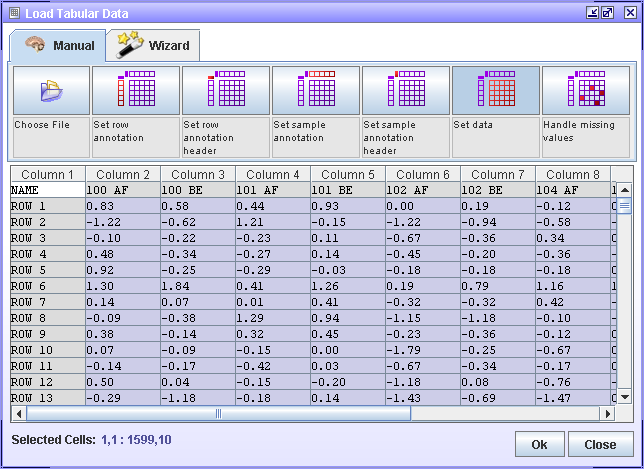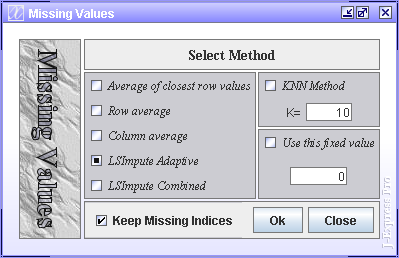Loading Tabular data
Tab or space delimited data files can be loaded into J-Express using the Load Tabular Data component
- Click the
 icon
on the toolbar, or click File on the menu bar. Select Load Tabular
data from the menu that appears.
icon
on the toolbar, or click File on the menu bar. Select Load Tabular
data from the menu that appears.
- Click the Manual tab in the data loader window that appears to give
you direct control of how data is imported to J-Express Pro. Click the
 icon (Choose File).
This brings up a file selection dialog where you can choose the file you want
to import the data from. Locate the file containing your data, and click OK.
An alternate way of loading data into the spreadsheet is to copy data from Microsoft
Excel and paste it directly into the spreadsheet. In that case the next step
is unnecessary.
icon (Choose File).
This brings up a file selection dialog where you can choose the file you want
to import the data from. Locate the file containing your data, and click OK.
An alternate way of loading data into the spreadsheet is to copy data from Microsoft
Excel and paste it directly into the spreadsheet. In that case the next step
is unnecessary.
- J-Express Pro allows data to be imported from files where the data fields
are delimited either by tabulator marks or by simple spaces. Select the appropriate
choice for your data file and click OK.

The data loader window
after setting the identifier, information and data areas.
- The contents of the data file will now appear in the data loader window.
To set external information on the rows (e.g. functional groups), click the
Set row annotation button, and select the appropriate column. Multiple columns of external information can be imported. The column(s) containing
the external information are highlighted when selected.
- Click the Set sample annotation button to select the row(s) containing the column
identifiers. Click on any cell in the row containing column identifiers to select
it. The selected row(s) will be highlighted.
- Click the Set data button to set the cells containing the actual data.
Click the upper leftmost cell containing a data entry, and then scroll to the
lower right cell containing data using the scrollbars. Hold down the Shift key
on the keyboard and click the last data cell. All the cells between the upper
left and lower right cells will now be selected as cells containing data. This
is indicated on the spreadsheet by a blue color.
- Microarray scanning and quantitation sometimes result in missing values
among the data. J-Express Pro allows you to manually correct these missing values
by double-clicking on the cell with an erroneous value and then enter a new
value. This method usually becomes unwieldy in a large dataset. If there are
a lot cells with missing cells the alternative is to use the missing values
dialog. Click on the Handle missing values button to bring
up this dialog.

The missing
values dialog helps replace erroneous data.
- Select a method, e.g. LSImputeAdaptive. See missing value explanation for more information on the different methods. Check the Keep Missing Indices to save these indices for
later. These indices can be used to overlook the missing values when calculating
distances (weighted euclidean) and in various forms of visualization (Hierarchical
clustering). For line charts, the line from or to a missing value will be absent.
- J-Express Pro is now ready to import
the external data. Press the "OK" button to import the
data and close the Data Loader Window. The loaded data will be available in the J-Express project window

